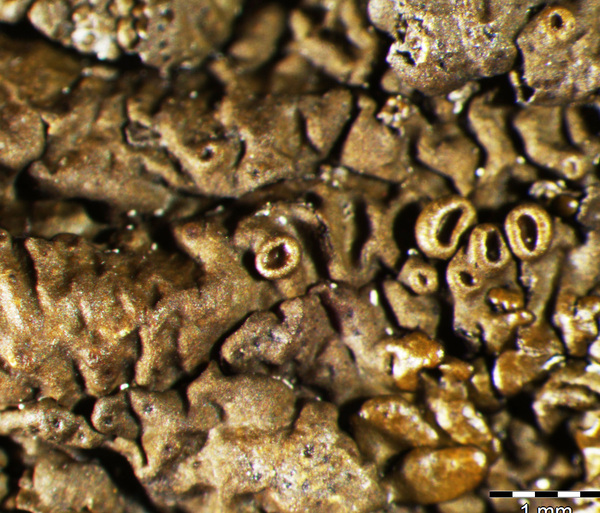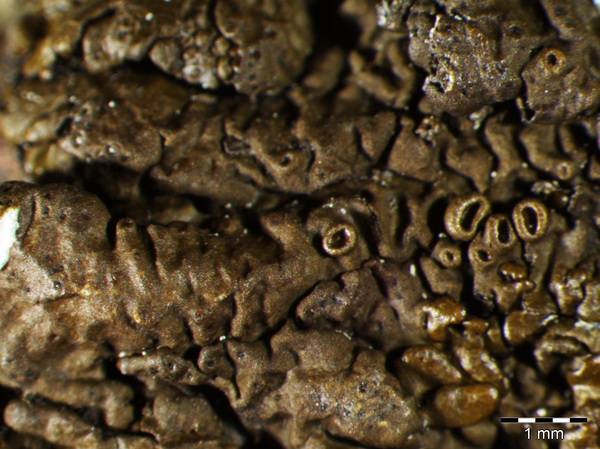Xanthoparmelia perrugata (Nyl.) O. Blanco, A. Crespo, Elix, D. Hawksw. & Lumbsch
Taxon, 53: 968, 2004. Basionym: Parmelia perrugata Nyl. - Flora, 68: 295, 1885.
Synonyms: Neofuscelia perrugata (Nyl.) Elix
Description: Thallus foliose, heteromerous, dorsiventral, adnate to tightly adnate, forming up to 10 cm wide, sometimes coalescing rosettes. Lobes 1-3(-5) mm wide, sublinear to linear-elongate, discrete to imbricate or entangled, the upper surface brown to dark brown, markedly uneven and rugose; thallus centre with dense warts, each with an apical depression, resembling young apothecia (a pycnidium is often present within a wart). Lower surface dark brown to black, moderately to densely rhizinate, the rhizines simple, to 1.5 mm long. Upper cortex paraplectenchymatous, with a pored epicortex, the cell walls with Xanthoparmelia-type lichenan; medulla white; lower cortex paraplectenchymatous. Apothecia usually numerous, lecanorine, sessile to stipitate, to 4 mm across, with a brown disc and a smooth thalline margin. Epithecium brown; hymenium and hypothecium colourless; paraphyses simple; hypothecium colourless. Asci 8-spored, clavate, the K/I+ blue tholus penetrated by a faintly amyloid apical cushion with parallel or diverging flanks, the wall K/I-, surrounded by a K/I+ blue outer layer, Lecanora-type. Ascospores 1-celled, hyaline, ellipsoid, 8-11 x 4-7 µm. Pycnidia common, immersed. Conidia weakly dumbell-shaped, 4.5-7 x c. 1 µm. Photobiont: chlorococcoid. Spot tests: upper cortex K-, C-, KC-, P-, N+ blue green; medulla K-, C-, KC- (very rarely KC+ fleeting pink), P-. Chemistry: medulla with divaricatic acid (major), stenosporic, oxostenosporic acids (minor), and variable amounts of gyrophoric acid.
Growth form: Foliose, broad lobed
Substrata: rocks
Photobiont: green algae other than Trentepohlia
Reproductive strategy: mainly sexual
Commonnes-rarity: (info)
Alpine belt: absent
Subalpine belt: very rare
Montane belt: rather rare
Dry submediterranean belt: rather rare
Humid submediterranean belt: rather rare
Padanian area: rare
pH of the substrata:
1 2 3 4 5
Solar irradiation:
1 2 3 4 5
Aridity:
1 2 3 4 5
Eutrophication:
1 2 3 4 5
Poleotolerance:
0 1 2 3
Altitudinal distribution:
1 2 3 4 5 6
Rarity
absent
extremely rare
very rare
rare
rather rare
rather common
common
very common
extremely common
Loading data...
Occurrence data
Predictive map
Growth form: Foliose, broad lobed
Substrata: rocks
Photobiont: green algae other than Trentepohlia
Reproductive strategy: mainly sexual
Commonnes-rarity: (info)
Alpine belt: absent
Subalpine belt: very rare
Montane belt: rather rare
Dry submediterranean belt: rather rare
Humid submediterranean belt: rather rare
Padanian area: rare
pH of the substrata:
| 1 | 2 | 3 | 4 | 5 |
Solar irradiation:
| 1 | 2 | 3 | 4 | 5 |
Aridity:
| 1 | 2 | 3 | 4 | 5 |
Eutrophication:
| 1 | 2 | 3 | 4 | 5 |
Poleotolerance:
| 0 | 1 | 2 | 3 |
Altitudinal distribution:
| 1 | 2 | 3 | 4 | 5 | 6 |
Rarity
absent
extremely rare
very rare
rare
rather rare
rather common
common
very common
extremely common
Loading data...
Occurrence data
Predictive map








